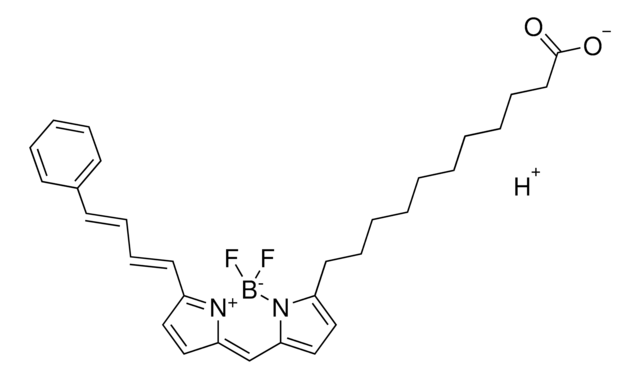SCT070
BioTracker NIM-7 Lipids and Lysosomes Live Cell Dye
Live cell imaging fluorescent probe for simultaneous dual-color tracking of lipid droplets and lysosomes
Iniciar sesiónpara Ver la Fijación de precios por contrato y de la organización
About This Item
UNSPSC Code:
12352207
NACRES:
NA.47
Productos recomendados
form
lyophilized
application(s)
cell analysis
detection method
fluorometric
General description
Lipid droplets (LDs) and lysosomes are specialized subunits within cells. LDs are the most hydrophobic sub-structures within cells and serve to store lipids for energy generation and membrane synthesis. Lysosomes are typically acidic organelles (pH 4.5–5.0) that play a critical role in the digestion and clearance of endocytosed and endogenous intracellular materials.BioTracker NIM-7 Lipids and Lysosomes Live Cell Dye is a naphthalimide-based fluorescent probe that allows lipid droplets and lysosomes to be labelled simultaneously and visualized separately using different excitation and detection channels. Lipid droplets and lysosomes can be visualized in the yellow and red fluorescence regions, respectively. The dye was found to have low cytotoxicity in multiple cell lines after 24 hour incubation. The dye also high photostability and can maintain 90% of original fluorescence intensity after 15 min of irradiation.Spectral properties:Lipid droplets: Excitation: 488 nm. Emission: 530-570 nm.Lysosomes: Excitation: 561 nm. Emission: 640-680 nm.Research Category:Live Cell DyeLipid Signaling
Disclaimer
Unless otherwise stated in our catalog or other company documentation accompanying the product(s), our products are intended for research use only and are not to be used for any other purpose, which includes but is not limited to, unauthorized commercial
Storage Class
11 - Combustible Solids
wgk_germany
WGK 3
flash_point_f
Not applicable
flash_point_c
Not applicable
Certificados de análisis (COA)
Busque Certificados de análisis (COA) introduciendo el número de lote del producto. Los números de lote se encuentran en la etiqueta del producto después de las palabras «Lot» o «Batch»
¿Ya tiene este producto?
Encuentre la documentación para los productos que ha comprado recientemente en la Biblioteca de documentos.
Nuestro equipo de científicos tiene experiencia en todas las áreas de investigación: Ciencias de la vida, Ciencia de los materiales, Síntesis química, Cromatografía, Analítica y muchas otras.
Póngase en contacto con el Servicio técnico

![Difluoro{2-[1-(3,5-dimethyl-2H-pyrrol-2-ylidene-N)ethyl]-3,5-dimethyl-1H-pyrrolato-N}boron 99% (HPLC)](/deepweb/assets/sigmaaldrich/product/structures/196/394/4c2c0eae-f749-44bf-a37b-84bf0226092e/640/4c2c0eae-f749-44bf-a37b-84bf0226092e.png)





